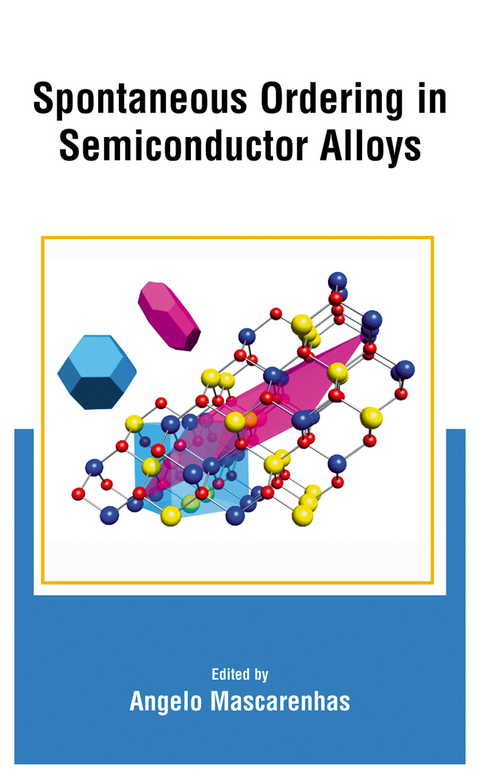
Spontaneous Ordering in Semiconductor Alloys
Springer-Verlag New York Inc.
978-1-4613-5167-2 (ISBN)
1. Basic Aspects of Atomic Ordering in III-V Semiconductor Alloys.- 1. Introduction.- 2. CuPt-B Atomic Ordering.- 3. TP-A and CuPt-A Atomic Ordering.- 4. Ordering Mechanisms.- 5. Concluding Remarks.- References.- 2. The Nature and Origin of Atomic Ordering in Group III-V Antimonide Semiconductor Alloys.- 1. Introduction.- 2. Atomic Ordering in Group III-V Antimonide Semiconductors Alloys.- 3. Origins of Atomic Ordering in Semiconductor Alloys.- 4. Conclusions.- References.- 3. Effects of the Surface on CuPt Ordering During OMVPE Growth.- 1. Introduction.- 2. Review of the Ordering Processes.- 3. Effects of Surfaces.- 4. Effects of Surfactants.- 5. Tellurium.- 6. Antimony.- 7. Summary.- References.- 4. X-Ray Diffraction Analysis of Ordering in Epitaxial III-V Alloys.- 1. Introduction.- 2. Overview of X-Ray Diffraction Theory.- 3. Long-Range Order.- 4. Reciprocal Space Mapping of Ordered Domains.- 5. Short-Range Order.- 6. Lateral Compositional Modulation.- 7. Summary.- References.- 5. Surface Morphology and Formation of Antiphase Boundaries in Ordered (GaIn)P—A TEM Study.- 1. Introduction.- 2. Transmission Electron Microscopy.- 3. Experimental.- 4. Results and Discussion.- 5. Summary.- References.- 6. X-Ray Characterization of CuPt Ordered III-V Ternary Alloys.- 1. Introduction.- 2. Results from TED and TEM Studies.- 3. X-Ray Diffraction Measurements.- 4. Structural Model and Diffraction Theory.- 5. Effect of the Atomic Displacements.- 6. Examples of Data Analyses.- 7. Determination of the Order Parameter.- 8. Summary.- References.- 7. Diffraction and Imaging of Ordered Semiconductors.- 1. Introduction.- 2. Ordered Semiconductors.- 3. Dynamical Diffraction.- 4. Analysis.- 5. Conclusions.- References.- 8. X-Ray Analysis of the Short-Range Order in the Ordered-AlloyDomains of Epitaxial (Ga,In)P Layers by DAFS of Superlattice Reflections.- 1. Introduction.- 2. Discussion.- 3. Conclusions.- References.- 9. Ballistic Electron Emission Microscopy and Spectroscopy Study of Ordering-Induced Band Structure Effects in Ga0.52In0.48P.- 1. Introduction.- 2. BEEM Technique.- 3. Experimental Set-Up.- 4. Results and Analysis.- 5. Conclusions.- References.- 10. Cross-Sectional Scanning Tunneling Microscopy as a Probe of Local Order in Semiconductor Alloys.- Reference.- 11. The Physics of Tunable Disorder in Semiconductor Alloys.- 1. Introduction.- 2. Ordering Induced Band Gap Reduction and Valence Band Splitting.- 3. Ordering Induced Optical Anisotropy or Polarization.- 4. Ordering Induced Changes in Effective Mass.- 5. Reflectance Difference Spectroscopy Study of Ordered Structure.- 6. Statistical Aspects of Spontaneous Ordering.- 7. Band Offset Between Ordered GaInP and GaAs.- 8. Novel Superlattices—Orientational Superlattices.- 9. Extrinsic Effects in Ordered GaInP.- 10. Conclusions.- References.- 12. Spectroscopic Study of the Interface and Band Alignment at the GaInP(Partially Ordered)/GaAs Heterojunction under High Pressure and High Magnetic Field.- 1. Introduction.- 2. Background.- 3. Sample Preparation and Characterization.- 4. Experimental Details.- 5. Experimental Results.- 6. Discussion.- 7. Conclusions.- References.- 13. Polarization Effects in the (Electro)absorption of Ordered GaInP and Their Device Applications.- 1. Introduction.- 2. Ordering Induced Effects on the Optical Transitions in GaInP.- 3. Polarization dependent Electro-Absorption.- 4. Polarization-Sensitive Devices.- 5. Conclusions and Outlook.- References.- 14. Phonons in Ordered Semiconductor Alloys.- 1. Introduction.- 2. Raman Scattering Studies.- 3. InfraredStudies.- 4. Phonons in Double Variant Ordered GaInP2.- 5. Conclusions.- References.- 15. Effects of Ordering on Physical Properties of Semiconductor Alloys.- 1. Introduction.- 2. Dependence on the Degree of LRO.- 3. Energy Level Shift and Splitting.- 4. X-Ray Structure Factor.- 5. Electric Field Gradient.- 6. Coupling of Ordering with Strain.- 7. Optical Anistropy in Ordered Alloys.- 8. Spin Polarization in Ordered Alloys.- 9. Effects of Stacking Faults.- 10. Summary.- References.- 16. Polarization Charges at Spontaneously Ordered (In,Ga)P/GaAs Interfaces.- 1. Background.- 2. Carrier Distribution at Interfaces.- 3. Effect of Spontaneous Ordering.- 4. Band Offsets and Interfacial Charges.- 5. Order-Induced Polarization Charges.- 6. Conclusions.- References.- Author Index.
| Zusatzinfo | XIX, 474 p. |
|---|---|
| Verlagsort | New York, NY |
| Sprache | englisch |
| Maße | 178 x 254 mm |
| Themenwelt | Naturwissenschaften ► Chemie ► Analytische Chemie |
| Naturwissenschaften ► Physik / Astronomie ► Allgemeines / Lexika | |
| Naturwissenschaften ► Physik / Astronomie ► Festkörperphysik | |
| Technik ► Elektrotechnik / Energietechnik | |
| Technik ► Maschinenbau | |
| ISBN-10 | 1-4613-5167-7 / 1461351677 |
| ISBN-13 | 978-1-4613-5167-2 / 9781461351672 |
| Zustand | Neuware |
| Haben Sie eine Frage zum Produkt? |
aus dem Bereich


